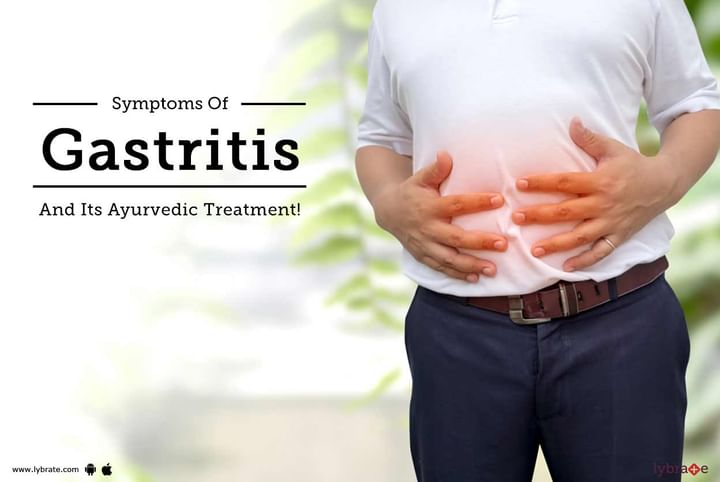Symptoms Of Gastritis And Its Ayurvedic Treatment!
Gastritis/acidity is a group of diseases or symptoms where there is excess secretion of acid by the gastric glands of the stomach.
If you have upper abdominal discomfort or pain, stomach fullness, heartburn, nausea, vomiting, indigestion, belching, waterbrash or irregular bowel movement, then you must be suffering from acidity or gastritis. It is a problem which becomes worse when an individual has poor eating habits and improper lifestyle.
Gastritis: swelling of stomach lining
Various factors like spicy food, medicines, tobacco, alcohol etc. Can cause increase in gastric acid production and disturb, weaken or damage the normal stomach lining. Gastritis occurs when there is an imbalance between the acid production and damage to the stomach lining, resulting in swelling of the stomach lining.
Gastritis a very common disorder of all age groups
Gastritis is of two types - acute gastritis (which occur suddenly) and chronic gastritis (develops over a period of time). In India gastritis is a very common disorder which occurs at any age but is more widespread in the adolescent age group (12-17 years). Adolescence is a change from childhood to adulthood, the period in which a lot of physical and psychological changes occur increasing the risk of gastritis.
Multiple factors cause gastritis
Various factors like spicy food, medicines (pain killers), tobacco, alcohol, emotional disturbance, psychological stress, smoking, alcohol intake and bacterial infection lead to gastritis.
Besides these, the three most important factors include helicobacter pylori infection (bacterial infection), use of painkiller medicines and autoimmunity (body loses its own immunity and attacks itself). These factors in the long term may even cause an ulcer (permanent breakage of the stomach lining), acid reflux disorder (food coming back to mouth after swallowing) and stomach cancer.
What does Ayurveda suggest?
In Ayurveda, agni refers to fire like activity in alimentary canal responsible for digestion of food which is influenced by the status of doshas. When samana-vata associates with kapha in turn produces weak digestive power (agni-mandya). Consuming food against the code of dietetics i. E. Ahara-vidhi vidhana and ahara-vidhi-visheshayatana (method of taking food) lead to a number of diseases related with food. Eating food before the previous food is digested, untimely food, eating too much of spicy or oily food, eating when not hungry, drinking too much water during food and at a time unless required, very hot high fatty-fried food, stale food, heavy diet, excess consumption of horse gram, vitiate all the three body humours (tridosha) also contribute to the symptoms of gastritis.
Due to the sourness of consumed food the liquidity of pitta increases further decreasing the capacity for digestion (agnimandya). Hence, rasadi-dhatu is not formed in a proper manner. This, after a certain period, manifests as amlapitta (hyperacidity).
Symptoms of gastritis vary among individuals
Symptoms of gastritis vary among individuals, and in many people even there are no symptoms. It also depends on the duration of disease, whether it is of acute (coming on suddenly) or chronic (causing symptoms over a long period of time) type.
The most common symptoms of acute gastritis include:
- Abdominal bloating or stomach fullness,
- Belching (expelling air from the stomach through the mouth)
- Waterbrashes (sour fluid or tasteless saliva into the mouth)
- Upper abdominal pain or discomfort
- Nausea/vomiting feeling
- Irregular bowel movement
- Recurrent indigestion,
- Chest burn or gnawing feeling between meals (heartburn)
- Hiccups etc.
In addition to this, symptoms of chronic gastritis may include weight loss, continuous flatulence, black stool, loss of appetite and even anemia.
How to diagnose gastritis?
To diagnose gastritis, performs a thorough physical evaluation, and may recommend a blood test for h. Pylori screening, stool test for blood in the stool. Abdominal x-rays or barium studies (upper or lower) may demonstrate the presence of thickened stomach lining and folds that are signs of inflammation in the stomach.
Sometimes, an endoscope, a thin tube containing a tiny camera, is inserted through the mouth and down into the stomach to look at the stomach lining (endoscopy). The doctor will check for inflammation and may perform a biopsy, in which a tiny sample of tissue is removed and sent for analysis of gastric lining. If you wish to discuss about any specific problem, you can consult an Ayurveda.



+1.svg)
